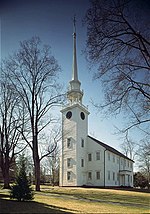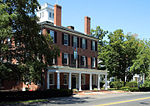Pequabuck River

The Pequabuck River is a river, approximately 19 miles (30.6 km) in length, which rises in Litchfield County, Connecticut, and courses through neighboring Hartford County before emptying into the Farmington River in Farmington. The river has played a crucial role in the development of Plainville, Connecticut, in particular. The river's lower drainage basin consists of industrial and urban areas, and effluents from these areas pollute the river's waters. The Pequabuck drove a water wheel that provided 8 horsepower to the Upper Lock Shop in Plymouth, Connecticut, a facility which would eventually become the Lewis Lock Company in 1851 and, finally, the once-renowned Eagle Lock Company.: 55 The river banks were historically the site of one of United States' first malleable iron-producing units, known as Malleable Iron Works (later Andrew Terry and Company).: 88
Excerpt from the Wikipedia article Pequabuck River (License: CC BY-SA 3.0, Authors, Images).Pequabuck River
Garden Street,
Geographical coordinates (GPS) Address Nearby Places Show on map
Geographical coordinates (GPS)
| Latitude | Longitude |
|---|---|
| N 41.719027777778 ° | E -72.839027777778 ° |
Address
Garden Street 188
06032
Connecticut, United States
Open on Google Maps









